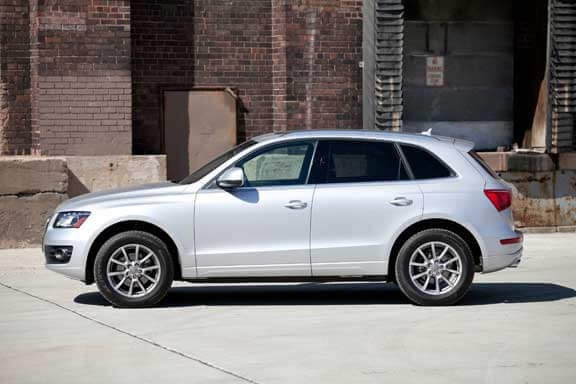 I’m a fan of premium compact crossovers — compelling, small packages in which carlike agility, luxury and cargo versatility unite. The five-seat Audi Q5 blends these attributes well, and its sleek profile and attractive LED head- and taillights make the cute-ute look both elegant and sporty.
I’m a fan of premium compact crossovers — compelling, small packages in which carlike agility, luxury and cargo versatility unite. The five-seat Audi Q5 blends these attributes well, and its sleek profile and attractive LED head- and taillights make the cute-ute look both elegant and sporty.
The 2012 Audi Q5 is the Goldilocks of the premium compact crossover class, offering a just-right blend of sporty road manners, comfortable driving dynamics, peppy power and plenty of cabin comfort.
The only change of note for 2012 is the addition of a new S line plus option package. It adds 20-inch titanium wheels and black matte exterior trim. The hybrid model slated for 2012 has been delayed until 2013. 2.0T Premium and the V-6-powered, uplevel 3.2 Premium Plus trims return for model-year 2012. I tested the 2.0T Premium. The Q5’s main competitors are the BMW X3, Cadillac SRX and Infiniti EX35. See all of them compared here.
A Balancing Act of Sport & Comfort
Although competitors from BMW and Infiniti offer six-cylinder power for a similar price, the four-cylinder Q5 has no trouble keeping up. In fact, the turbocharged engine never feels slow. The 2.0T’s 211-horsepower rating may seem lacking compared with the SRX (308 hp) and EX35 (297 hp), but the Q5’s turbo makes up for it with 258 pounds-feet of torque. It feels robust from a stop and competently delivers more power for highway maneuvers.
The Q5’s eight-speed automatic transmission is alert overall, sometimes to the point of feeling busy, but it’s generally responsive, with prompt kick downs. A hint of turbo lag delays acceleration at the start, but drivers should be able to acclimate.
Top fuel economy numbers expand this engine’s appeal: The Q5 2.0T’s EPA rating is 20/27 mpg city/highway. I drove 194 miles in an approximate 60/40 city/highway split and got 23 mpg. Cadillac’s SRX is rated 16/23 mpg and the Infiniti EX35 is rated 17/24 mpg.
The Q5’s ride and handling balance lends it a sporty feel. Though its ride is on the firm side, it’s never jittery or uncomfortable. The payoff is sharp handling. The Q5 feels carlike and agile, with great roadholding even in fast corners. The X3 and EX35 match it for handling, but the Q5 absorbs bumps better.
In terms of steering, the Q5 is a mixed bag. It has speed-sensitive steering, so it feels light and over-boosted in low-speed maneuvers, then firms up at higher speeds.
Cabin Hits & Misses
High-quality leather and soft-touch plastics give the Q5’s cabin an expensive look and feel, but — and this is a big but — Audi’s interior designers should go back to color class. Jet black and cinnamon brown simply do not get along, and confined spaces only amplify garish color combinations.
A subjective matter, you say? I usually agree, but every one of my passengers commented on it, including my husband, who’s normally blind to such egregious fashion faux pas. The Q5 isn’t the only victim; Audi does this in several of its vehicles. Luckily, there are a couple other color combinations to choose from, including light gray, beige and black. The only way to get the brown seats, however, is with the black interior. The rest of the cabin is tastefully trimmed in walnut wood.
Though loud to look at, the cabin itself is impressively hushed. Road noise is well-muffled, but the standard roof rails with removable cross bars induce some wind noise at highway speeds.
Front-seat occupants have ample room. The driver’s comfort is further aided by a cushy, supportive front seat with standard 12-way power adjustment, including lumbar support.
The confines aren’t as friendly in the backseat, where taller passengers will need more space. Legroom is tight, though the sliding and reclining seat helps; it’s a rarity in this class. Although the optional panoramic moonroof is lovely, it shaves precious inches of headroom.
The premium compact crossover class is not the place you want to be shopping if you’re looking for second-row legroom. With 37.4 inches of space, however, the Q5 offers more legroom than the X3 (36.8 inches), SRX (36.3 inches) and EX35 (28.5 inches).
The 60/40-split backseat folds simply from the rear doors or from the cargo area. Folding it yields 57.3 cubic feet of space and an almost flat load floor. There’s also a small storage compartment under the floor. Seats up, the Q5 has 29.1 cubic feet — more than the X3 and EX35 offer with the seats up and enough for a big trip to the grocery store. Its power hatch is a nice convenience, though it’s available only in a pricey option package. This feature is optional on the SRX and X3 and unavailable on the EX35.
MMI: Made Me Insane
If you end up with a Q5, book a few hours with the owner’s manual to read up on Audi’s Multi-Media Interface, which takes a lot of getting used to. Although I’m familiar with MMI, we still needed time to get reacquainted. The system absorbs and centralizes a lot of climate, audio and navigation functions, turning most simple tasks into multistep processes. For example, to change the radio presets, you’ll have to drill through several menus. It left me longing for a simple button to push.
Physically, MMI’s main control knob is ergonomically placed and doesn’t require much of a stretch. The radio volume, however, is controlled via a console knob that’s set far from the driver and requires an awkward reach. Thankfully, steering-wheel controls are standard.
The upside to MMI is its functions: The real-time weather and traffic data were helpful. The voice-command system understood “next coffee shop” and displayed several in my area. I selected my favorite one and got turn-by-turn directions.
All the caffeine in the world couldn’t improve the navigation’s functionality, however. Inputting an address requires twisting the console-mounted knob to find and select each number and letter. A touch-screen would really help. Getting lost and wandering into my destination would probably take less time.
To be fair, BMW’s iDrive system in the X3 is similarly complicated. The EX35’s touch-screen and simplified menu structure, however, are much more intuitive.
Features & Pricing
A base price of $35,600 gets you standard all-wheel drive, brake assist, hill-descent control, dual-zone automatic climate control in front with separate rear controls, a tilt/telescoping leather-wrapped steering wheel with audio controls, leather seats and surfaces, 12-way power front bucket seats and a cooled glove box.
The Premium Plus Convenience Package adds $4,300 to the sticker and features LED daytime running lights, auto-dimming and power-folding mirrors, heated front seats with driver memory function, stainless-steel exterior trim, a panoramic moonroof and a power liftgate. The $3,000 MMI Navigation Plus Package includes the multimedia system, HD radio and navigation with voice control, and a backup camera with parking sensors.
Audi’s Advanced Key keyless entry system added $550, which brought my test Q5’s final price to $44,800 after the $875 destination fee. Despite its hefty price tag, it stacks up well against similarly priced competition in this expensive class.
Safety
The 2012 Q5 received the Insurance Institute for Highway Safety’s highest score, Good, in frontal offset, side-impact, rear-impact, and roof-strength crash tests, making it a Top Safety Pick. The National Highway Traffic Safety Administration last rated the Q5 for the 2010 model year, before NHTSA’s more stringent tests took effect for 2011.
Standard safety features include frontal and side-impact airbags for the front seats, plus side curtain airbags for head protection in the front and rear seats. Side-impact airbags for torso protection are optional for the backseat. As is required of all 2012 models, antilock brakes and an electronic stability system are standard. For a full list of standard safety features, check out theStandard Equipment & Specs page.
The Q5 offers several active-safety options, but they’re not available across the entire lineup: A helpful backup camera comes only in an expensive package. (It’s a stand-alone option on the X3, standard on the EX35 and standard on uplevel versions of the SRX.) Similarly, a blind spot warning system isn’t available on 2.0T versions of the Q5.
The Q5 has a refreshingly easy Latch system for installing child-safety seats. Plastic, removable covers make finding the anchors a breeze (though I’d lose the plastic covers within a day). Click here to read our full Car Seat Check.
Q5 in the Market
With a base price of $35,600, the Audi Q5 may sound pricey, but if you’re shopping in this segment you’re not looking for a budget vehicle. The Q5’s bottom line can escalate quickly, though, especially considering many features are available only in expensive option packages. Still, the Q5 2.0T is a relative bargain, given that the V-6-powered Q5 3.2
Premium Plus starts at $43,000.
All-wheel-drive versions of the Infiniti EX35 and BMW X3 start at $37,200 and $37,100, respectively. The Cadillac SRX starts at $35,485, but all-wheel drive isn’t available on the base model. Aside from the V-6 engines they offer, equipment levels at this price are similar, which really puts the Q5’s base price into perspective. What sets the Q5 apart is its balance of sport and comfort. It stands out as a stylish, fun-to-drive compact crossover with the luxury trappings buyers expect.
Bonus: It also offers a little more passenger and cargo room than its competitors.































